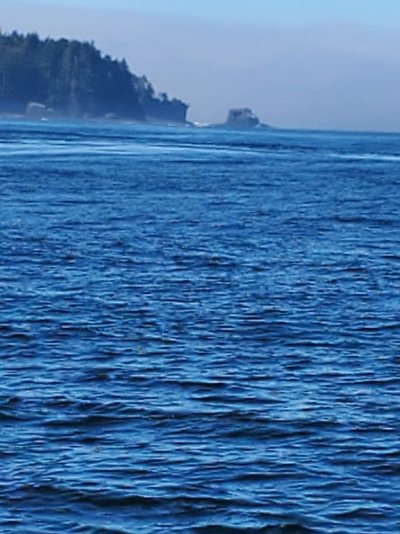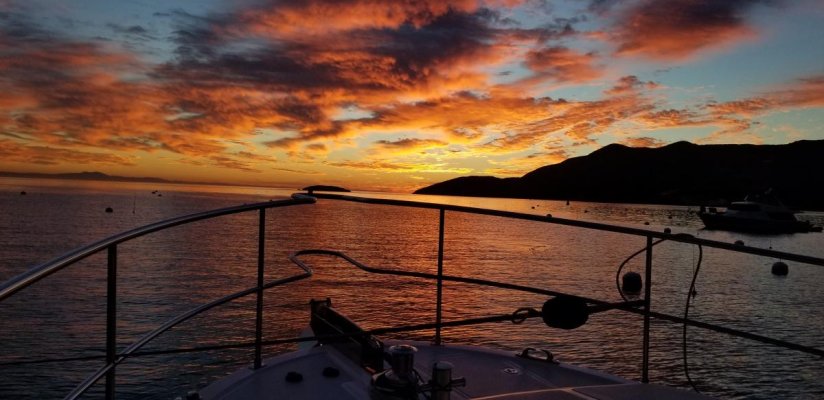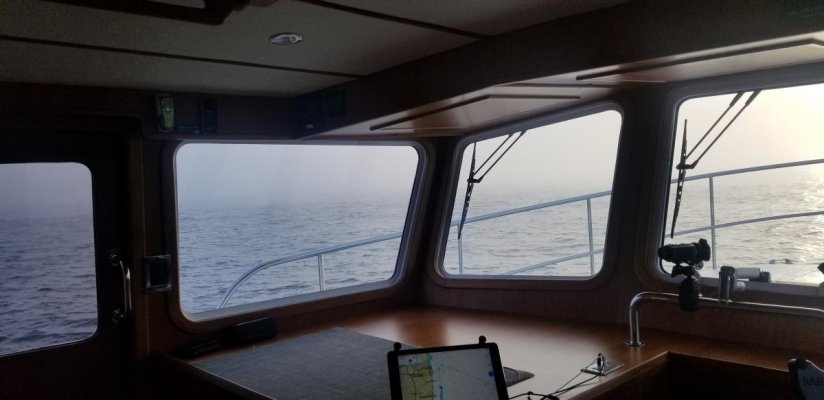You are using an out of date browser. It may not display this or other websites correctly.
You should upgrade or use an alternative browser.
You should upgrade or use an alternative browser.
2022 cruising, So Where are You Going?
- Thread starter O C Diver
- Start date
The friendliest place on the web for anyone who enjoys boating.
If you have answers, please help by responding to the unanswered posts.
If you have answers, please help by responding to the unanswered posts.
Datenight
Guru
The past three weeks we have been in Pt. Judith, RI, Cuttyhunk, MA, Edgartown, Martha’s Vineyard, Nantucket, lake Tashmoo, Martha’s Vineyard, Quissett Harbor (Falmouth, MA), Dutch Harbor (Jamestown, RI) Battleship Cove (Fall River, MA) East Greenwich, RI. Presently in an old favorite, Wickford, RI.
Enjoying every minute.
Rob
Enjoying every minute.
Rob
Jeff F
Guru
- Joined
- Nov 5, 2015
- Messages
- 2,437
- Location
- Canada
- Vessel Name
- Escapade
- Vessel Make
- 50` US Navy Utility trawler conversion
Are you heading back via Buffalo?Well summer will be over in a couple weeks and it's time for this snowbird to be heading South. Need to be off the Lakes by mid September. Had a great 16 day adventure to Isle Royale and now heading across the South shore of Superior to anchor in Whitefish Bay this evening. Came into Superior with calm seas and heading out 43 days later, the same way.
View attachment 131133
Ted
I'm in Georgian Bay, thinking about the latest I can head south. Mid September is beautiful around here, and empty.
Sounds like your trip has gone as planned.
Sent from my moto g play (2021) using Trawler Forum mobile app
O C Diver
Guru
- Joined
- Dec 16, 2010
- Messages
- 12,880
- Location
- USA
- Vessel Name
- Slow Hand
- Vessel Make
- Cherubini Independence 45
Ring the bell 29 times in Whitefish Bay.
So I'm anchored just below Whitefish Point night before last, about 13 miles from where the Edmund Fitzgerald sank.
So I'm looking at the plotter (AIS) to see who's coming up behind me. It's the Arthur Anderson (boat traveling behind the Edmund Fitzgerald when it sank and then turn around and went back out looking for survivors).

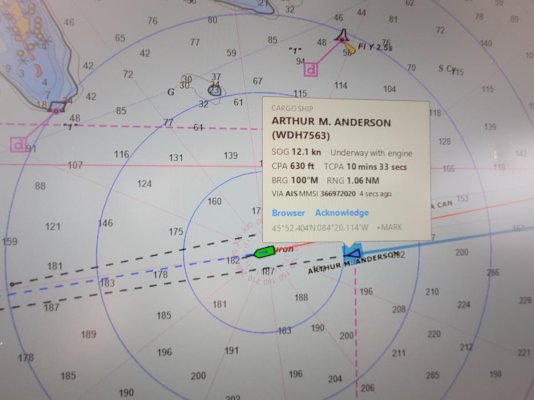
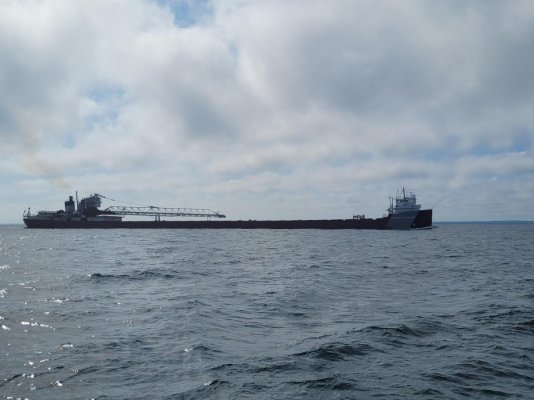
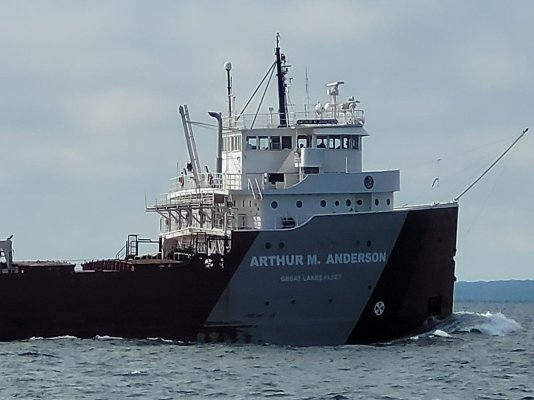
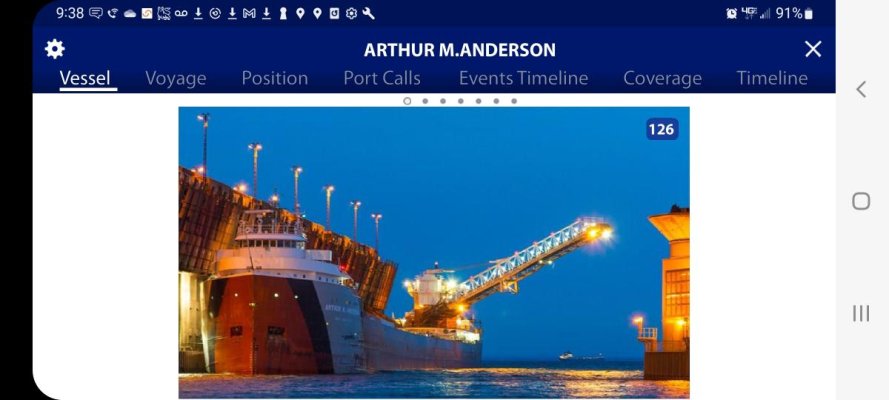
70 years young!
Ted
Last edited:
Jeff F
Guru
- Joined
- Nov 5, 2015
- Messages
- 2,437
- Location
- Canada
- Vessel Name
- Escapade
- Vessel Make
- 50` US Navy Utility trawler conversion
So I'm anchored just below Whitefish Point night before last, about 13 miles from where the Edmund Fitzgerald sank.
So I'm looking at the plotter (AIS) to see who's coming up behind me. It's the Arthur Anderson (boat traveling behind the Edmund Fitzgerald when it sank and then turn around and went back out looking for survivors).
I just saw this on a ship forum I follow.
ON THIS DAY IN HISTORY 14 1962
On this day in 1962, the ARTHUR M. ANDERSON departed Conneaut and headed downbound to become the first Pittsburgh boat to transit the Welland Canal and St. Lawrence Seaway.
One of the better-known lakers is the Arthur M. Anderson. Renowned for her role involving the loss of the Edmund Fitzgerald on Nov. 10, 1975, the Arthur M. Anderson was the last vessel to have had visual, radio and radar contact with the Edmund Fitzgerald. Built by the American Shipbuilding Co., Lorain, OH, as hull #868, the Anderson was launched Feb. 16, 1952 for the Pittsburgh Steamship Div., U.S. Steel Corp., in Cleveland, OH, by Mrs. Anderson in honor of her husband. Arthur Marvin Anderson was a director of the United States Steel Corp., a member of its finance committee and vice chairman of the J. P. Morgan and Co. at the time of the launch.��In the summer of 1950, Pittsburgh Steamship had announced the building of three new vessels following the trend set by other Great Lakes shipping companies in upgrading their fleets in the early 1950s. Given the fleet designation AAA class, the Arthur M. Anderson was the second of the three identical sisterships to enter service for the fleet in 1952. The other two were Philip R. Clarke, built in 1951 at American Shipbuilding Co., entering service in May 1952 and Cason J. Callaway, built in 1952 at Great Lakes Engineering Works, River Rouge, MI, and entering service in September 1952. The three bulkers have all remained in service, have stayed with the same fleet and have retained their original christened names throughout their careers. A fourth identical sister, William Clay Ford (1) was launched in 1953 for the Ford Motor Co., Dearborn, MI, and was scrapped at Port Maitland, ON in 1987. Of note, the AAA designation was an internal U.S. Steel accounting code used for fleet vessel classification by differentiating their ships according to size thus determining pay scales for shipboard personnel. Basically the larger and more powerful the vessel, the more the officers were paid. Arthur M. Anderson, Cason J. Callaway, and Philip R. Clarke, as well as the self-unloader John G. Munson, all fit the similar criteria, thus the common accounting code designation. The four identical sister ships are loosely classed together four 4 other bulkers built in the early 1950s of nearly the same design, size and power, these being the Edward B. Greene (1952), J.L. Mauthe (1952), Reserve (1952) and Armco (1953). The shipping industry generally classified these eight bulkers as the Pittsburgh class.��Arthur M. Anderson and her sister ships were never the largest, but relative to their size, were considered among the most powerful bulkers built for the Great Lakes at the time. The design was similar to, but an expanded and modified version of the Maritime class built during World War II, examples being Cuyahoga, Manistee and Mississagi. The hull streamlining introduced with the war builds was further refined and the bows and sterns modified based on extensive model testing. Water flow to the propeller was improved by an asymmetrically designed hull by the stern. The rudder was offset slightly to function more efficiently in the flow of water back from the prop. Also included in the vessels' construction was the use of alternating current electrical power and on-board sewage treatment capabilities, both firsts for the Pittsburgh fleet. The addition of the Anderson, Callaway and Clarke gave the Pittsburgh Steamship fleet a total of 64 steamers at the end of the 1952 season.��As completed, Arthur M. Anderson's overall dimensions were 647' 00" loa x 70' 00" beam x 36' 00" depth with a capacity of 21,000 tons dwt at a mid-summer draft of 26' 02". The cargo was contained in three holds serviced by 19 hatches (6-7-6 configuration). After the St. Lawrence Seaway opened in 1959, she could carry 20,800 tons at the early Seaway draft of 26' 00.” Power was and still is supplied by a 7,700 s.h.p. cross-compound steam turbine engine (steam expanded through two turbines) built by Westinghouse Electric & Manufacturing Co. Ltd., Pittsburgh, PA, with two heavy-fuel oil fired Foster-Wheeler water tube boilers providing the steam; the power then transmitted to the single controllable pitch propeller through double reductions gears driving the bulker at a speed of 16 m.p.h. The beam (width) of the Anderson and her sisters was set at 70' 00" since it was determined in the late 1940s when they were being designed that the loading chutes of the upper lakes ore docks could not service vessels of any greater width.��After the completion of sea trials on August 7, 1952, Arthur M. Anderson was commissioned Aug. 10, 1952 and departed the same day on her maiden voyage from Lorain, OH, in ballast to Two Harbors, MN, to load iron ore. During her first full season of sailing, the vessel carried a record 866,855 tons in 46 trips. In August that year, the Pittsburgh fleet carried 4.1 million tons, the first time the fleet broke the 4 million ton mark; of that tonnage, the Anderson, Callaway and Clarke carried 358,000 tons. The bulker was noted to have opened the Duluth / Superior shipping season for 1957 on April 9, the late opening caused by the worst ice conditions on the lakes in over 50 years. On July 13, 1961, the bulker had the honor of opening the newly deepened West Neebish Rock Cut portion of the St. Marys River system. Then, on July 18, 1961, the Anderson grounded in fog on a mud bank in the upper St. Marys River. She was freed after lightering.��The year 1962 marked a milestone for the fleet when the Arthur M. Anderson became the first member of the Pittsburgh fleet to transit the relatively new St. Lawrence Seaway system. She departed Conneaut, OH, on August 14, 1962 proceeding downbound through the St. Lawrence Seaway system arriving at Port Cartier, QC, on August 17, 1962 to load Canadian iron ore for Gary, IN. The Anderson made one more Seaway transit that year, her fleet mates Philip R. Clarke also making two Seaway transits and Cason J. Callaway making one transit in 1962. A bow thruster was added to the Anderson in 1966.��Arthur M. Anderson (with her fleet mates Roger Blough, Cason J. Callaway, Philip R. Clarke, John G. Munson and Presque Isle) were participants in the U.S. government's demonstration program in the experimental extension of the navigation season to a full 12 months during the winters of 1974/75 and 1975/76.��The Anderson was lengthened by 120' during the spring of 1975 at Fraser Shipyards, Inc., Superior, WI. As completed, the Anderson's new length was 767' 00" with 24 hatches servicing three holds and an increase in capacity to 26,525 tons at a mid-summer draft of 27' 00.” The hatch placement over the three holds was originally 6, 7 and 6 becoming 6, 12 and 6 with the lengthening.��The Arthur M. Anderson's most notable claim to fame, and perhaps the reason her name is engraved in the annals of Great Lakes maritime history, is for the role she played relating to the Edmund Fitzgerald disaster in the early evening Monday, November 10, 1975. On a sunny November 9, 1975, the Anderson departed Two Harbors, MN into Lake Superior with a load of ore for Gary, IN. Shortly after departure, she was overtaken by the Edmund Fitzgerald, which had left Superior two hours earlier (1:15 p.m.) with a load of taconite ore for Zug Island on the Detroit River. The two captains (Capt. Jesse B. Cooper of the Anderson and Capt. Ernest M. McSorley of the Fitzgerald) agreed to run together maintaining radio and radar contact with each other on their Lake Superior transit through a forecasted storm, taking the longer route following the Canadian shore. This route afforded more protection from the winds and waves for most of the trip versus the more direct route across the lake that would expose them to the full force of the storm. However, on their last leg of their run following the eastern Canadian shore of Lake Superior toward Whitefish Bay, they were exposed to extremely heavy following seas of 20 to 30 feet. The Anderson lost sight of the lights of the Fitzgerald in a squall and then the Fitzgerald disappeared from the Anderson's radar screen. Emerging from the squall, the lights of the Fitzgerald were also gone. Repeated radio calls to the Edmund Fitzgerald went unanswered, and no ships either in or leaving Whitefish Bay reported seeing the Fitzgerald come off the lake. The Anderson reported the missing vessel to the U.S. Coast Guard. After conducting a futile search of the area for survivors, the Anderson entered into the protection of Whitefish Bay from the stormy Lake Superior in the early hours of Nov.11.��The U.S. Coast Guard next requested the Anderson to reverse course and assist in conducting another search for the Fitzgerald. The U.S. Coast Guard also requested assistance from the other vessels anchored in Whitefish Bay riding out the storm. Responding along with the Anderson were the U.S. vessels William Clay Ford, Armco, Roger Blough, Reserve, Wilfred Sykes and William R. Roesch and the Canadian vessels Hilda Marjanne, Frontenac, John O. McKellar, Murray Bay and fishing tug James D. No survivors were found nor were any bodies recovered. The Anderson sighted one piece of a lifeboat at 8:07 on Nov. 11 about nine miles east of where the Fitzgerald disappeared and an hour later sighted the second damaged lifeboat about four miles south of the first one. Other than the eventual recovery of the severely damaged lifeboats, the extensive search resulted in only the recovery of various pieces of floating debris from the sinking. The Fitzgerald was later found in Canadian waters 530 feet below the surface of Lake Superior 15 nautical miles from Whitefish Bay.��Later, Capt. Cooper was noted to have said, "I know one thing, at 3:20 in the afternoon, that ship received a mortal wound. She either bottomed out or suffered a stress fracture. I think she bottomed out." Continuing, "I honestly believe they knew they were in trouble, but Whitefish Bay was only 14 miles away and he (McSorley) thought he could make that."��The sinking of the Edmund Fitzgerald is now legend. It has been the subject of exploration, television documentaries, various media presentations, books, reports, theories, conjecture and a song.��A few weeks later, the Anderson began the second winter of the year-round navigation of the Great Lakes experiment. On Jan.31, 1979, the Anderson collided with the stern of the U.S. Coast Guard icebreaker Westwind while the icebreaker was breaking a path through Lake Erie to Ashtabula, OH, for the Anderson. The bulker's bow was holed from about the 29 foot mark upward about 12 to 15 feet with buckling of the main and forecastle decks. Repairs were completed at Milwaukee, WI, after which she shuttled iron ore pellets from Indiana Harbor, IN to Gary, IN due to severe ice conditions on the upper lakes.��Arthur M. Anderson was converted to a self-unloader during the 1981/82 winter lay up at the Fraser Shipyard, Superior, WI, arriving there Nov. 1, 1981. Prior to the Anderson arriving, the yard workers had built 23 sections of hopper bottom that would make up the inside of the holds. These sections were each prefabricated with the electrical wiring, piping and the conveyor structure in place. Then, with the vessel in drydock, the bottoms of the holds were removed. Each prefabricated section was carefully lowered through the appropriate hatch, aligned and welded together to form the continuous hopper bottom. The sides of the holds were sloped to allow for the gravity feeding of the cargo through 74 hydraulically controlled gates to a single 78-inch wide continuous loop conveyor belt running the cargo below the holds to the stern of the vessel. The cargo was then lifted by a loop-belt elevator system up to the deck and on to a 250 foot long unloading boom installed just forward of the aft deckhouse. This self-unloading system could unload the Anderson at a rate of up to 6,000 tons per hour. Her new configuration included increasing the number of holds from three to five and reducing the number of hatches from 24 to 23 (4-5-5-5-4 configuration), her capacity dropping from 26,525 tons to 25,300 tons. On April 29, 1982, the Anderson left the Fraser yard and moved across the harbor to the chutes of the DMIR Railway ore docks to test her new equipment and load her first cargo of taconite pellets carried as a self-unloader.��Further upgrades included the installation of a stern thruster in 1989, making the vessel very maneuverable in the tight spaces of some rivers and ports and the reconfiguring of the number of holds from 5 to 7 (3-3-4-4-4-3-2 configuration). The seven holds give the Anderson the flexibility to carry multiple grades or types of commodities to one or several locations. In the mid 1990s, the vessel's self-unloading boom was lengthened to 262 feet, further increasing the vessel’s flexibility.��On April 6, 1999, the Arthur M. Anderson grounded while inbound to Calcite, MI, in the shipping channel about 1.000 feet from the pier due to low water levels. There was no pollution nor personnel injuries but three double bottom ballast tanks were holed and flooded. The next day, the Anderson was refloated with tug assistance after lightering 7,100 short tons of limestone to the bulker Wolverine. She was moored at Calcite's pier for inspection and departed April 8 for Sturgeon Bay, WI, for repairs.��In March 2001 after U.S. Steel had completely divested itself from any involvement in transportation, Arthur M. Anderson and her fleet mates sailed for new fleet owners USS Great Lakes Fleet, Inc., Duluth, MN, a subsidiary of Great Lakes Transportation, Monroeville, PA. By 2003, the fleet’s name was shortened to just Great Lakes Fleet Inc. In 2004, Great Lakes Fleet Inc. was acquired by Canadian National Railway Co., Montreal, QC, as part of that company’s acquisition of several U.S. regional railway interests. Now known formally as Great Lakes Fleet, the ships remain U.S.-flagged and based in Duluth, MN, sailing under the management of Key Lakes Inc., Bala-Cynwyd, PA, in compliance with the Jones Act.��Early on July 15, 2001, the Arthur M. Anderson grounded near Port Inland, MI. She was refloated and under way shortly after with no reported damage. On June 14, 2003, the Anderson struck the sheet pile bulkhead on the Fox River at Green Bay, WI. She was turning in the Green Bay East Turning Basin with the tug Texas assisting when the incident occurred. The Anderson's bow did not come around fast enough due to a strong northeast wind and a strong inbound river current at the time. The Anderson was undamaged but the bulkhead received about $75,000 in damages. Later, while moored at the Carmuse Lime dock on the Rouge River, the Herbert C. Jackson struck the port quarter of the Anderson's port lifeboat. Damage was slight and no repairs were necessary.��Arthur M. Anderson continued to sail as part of the Great Lakes Fleet, the derivative of the original Pittsburgh Steamship fleet, until Jan. 15, 2017. On that date she entered what was believed to be long-term layup at the Canadian National Dock 6 in western Duluth, MN, to be held in reserve until business conditions warranted a return to service.��Good news came on April 2, 2019, when tugs from Heritage Marine moved the Anderson to nearby Fraser Shipyards for a refit expected to cost around $4 million in order to return her to active service later in the season.��According to Mitch Koslow, vice president of Key Lakes Inc., which operates the vessel for Canadian National Railway's Great Lakes Fleet, which is operated by Key Lakes, the economy had improved and the amount of cargo booked by the company risen. "It's all about commercial and market conditions," Koslow said. "Things have improved to the point where we can use (the Anderson) to meet the needs of our customers."��Written by George Wharton.
Sent from my moto g play (2021) using Trawler Forum mobile app
Fletcher500
Guru
Cruising 2022
We are wrapping up our cruising for 2022. My wife is still working, so she comes and goes and meets me at various points but she still managed to do some extended travel with me to Catalina, Santa Cruz, and Anacapa Islands for several trips. Starlink is on the list for Q1 for improved connectivity, mainly for her, because I actually enjoy being off line.
Today is my last day in the Channel Islands. The past few days were amazing, low crowds, great weather, and warm water (still trunking it). The high pressure is starting to break and a low is heading our way. I am therefore cutting this visit short, and heading home tomorrow. Sunset this morning: “Red sky in morning…”.
Hope everyone had a great 2022.
Fletch.
We are wrapping up our cruising for 2022. My wife is still working, so she comes and goes and meets me at various points but she still managed to do some extended travel with me to Catalina, Santa Cruz, and Anacapa Islands for several trips. Starlink is on the list for Q1 for improved connectivity, mainly for her, because I actually enjoy being off line.
Today is my last day in the Channel Islands. The past few days were amazing, low crowds, great weather, and warm water (still trunking it). The high pressure is starting to break and a low is heading our way. I am therefore cutting this visit short, and heading home tomorrow. Sunset this morning: “Red sky in morning…”.
Hope everyone had a great 2022.
Fletch.
Attachments
Alaskan Sea-Duction
Guru
- Joined
- Jul 6, 2012
- Messages
- 8,062
- Location
- USA
- Vessel Name
- Alaskan Sea-Duction
- Vessel Make
- 1988 M/Y Camargue YachtFisher
Christmas Ships in December at St. Helens OR will be our last cruise for 2022, But:
Starting 2023 with the Seattle Boat show end of January! Getting projects done and preparing for the trip North.
Starting 2023 with the Seattle Boat show end of January! Getting projects done and preparing for the trip North.
O C Diver
Guru
- Joined
- Dec 16, 2010
- Messages
- 12,880
- Location
- USA
- Vessel Name
- Slow Hand
- Vessel Make
- Cherubini Independence 45
Should be back to Fort Myers 2nd week of November. Cold front came through a few days back. 35 degrees this morning and the morning before in the Dismal Swamp. Need to get south!
https://dismalswampwelcomecenter.com/history/
Ted
https://dismalswampwelcomecenter.com/history/
Ted
rslifkin
Guru
- Joined
- Aug 20, 2019
- Messages
- 7,599
- Location
- USA
- Vessel Name
- Hour Glass
- Vessel Make
- Chris Craft 381 Catalina
Should be back to Fort Myers 2nd week of November. Cold front came through a few days back. 35 degrees this morning and the morning before in the Dismal Swamp. Need to get south!
https://dismalswampwelcomecenter.com/history/
Ted
Wow, that's a couple of degrees colder than we've had overnight up here. We've gotten close, but at least our cold snap is supposed to break tomorrow. Hopefully yours does too!
O C Diver
Guru
- Joined
- Dec 16, 2010
- Messages
- 12,880
- Location
- USA
- Vessel Name
- Slow Hand
- Vessel Make
- Cherubini Independence 45
Yes, tomorrow is the last cold morning.Wow, that's a couple of degrees colder than we've had overnight up here. We've gotten close, but at least our cold snap is supposed to break tomorrow. Hopefully yours does too!
Ted
Hippocampus
Guru
- Joined
- Jul 27, 2020
- Messages
- 3,923
- Location
- Plymouth
- Vessel Name
- Hippocampus
- Vessel Make
- Nordic Tug 42
Slowly heading south. Started in RI now in Atlantic Highlands. Leave tomorrow for Cape May. Then up and down the bays to end up in Deltaville. 2 week stop for boat work and a break at home . Then Hilton head. Then a break at home. Then will decide.
Alaskan Sea-Duction
Guru
- Joined
- Jul 6, 2012
- Messages
- 8,062
- Location
- USA
- Vessel Name
- Alaskan Sea-Duction
- Vessel Make
- 1988 M/Y Camargue YachtFisher
I have heard of the "Great Migration" to Southern ports. Have you considered the damage by Ion in planning?Slowly heading south. Started in RI now in Atlantic Highlands. Leave tomorrow for Cape May. Then up and down the bays to end up in Deltaville. 2 week stop for boat work and a break at home . Then Hilton head. Then a break at home. Then will decide.
O C Diver
Guru
- Joined
- Dec 16, 2010
- Messages
- 12,880
- Location
- USA
- Vessel Name
- Slow Hand
- Vessel Make
- Cherubini Independence 45
Slowly heading south. Started in RI now in Atlantic Highlands. Leave tomorrow for Cape May. Then up and down the bays to end up in Deltaville. 2 week stop for boat work and a break at home . Then Hilton head. Then a break at home. Then will decide.
Hilton Head is very nice. You won't get Massachusetts winter, but you will still have some doses of a milder winter.
Ted
psneeld
Guru
Yes, tomorrow is the last cold morning.
Ted
We are back in FT Pierce now Ted. Stop by if you want or need anything.
diver dave
Guru
- Joined
- Jan 13, 2017
- Messages
- 2,570
- Location
- United States
- Vessel Name
- Coquina
- Vessel Make
- Lagoon 380
Wearing jeans and long sleeves in st aug last couple days.
Hippocampus
Guru
- Joined
- Jul 27, 2020
- Messages
- 3,923
- Location
- Plymouth
- Vessel Name
- Hippocampus
- Vessel Make
- Nordic Tug 42
We figured to use Hilton head for awhile. Will leave the boat there for around two months to go home for a grandson’s first b’day then hang at home through Xmas and New Years. Then maybe cruise around Hilton head or continue south. Have boating friends in FLA so some of it depends upon what they do. May join up and buddy boat. Also have boating friends in NC who may want to cruise on our boat for awhile. Although retired still have obligations but do have the freedom to pick a direction not a destination which has been liberating.
motion30
Guru
- Joined
- Jan 14, 2010
- Messages
- 1,181
I left Key West before the storm, Heading back in the next couple of days , into the boat yard for bottom paint and then hopefully off to the Bahamas
Sailor of Fortune
Guru
Wearing jeans and long sleeves in st aug last couple days.
yup , was 40's the other morning when I woke up.... Only got up to high 60's during the day... After being in low 80's all week...
Fletcher500
Guru
Similar threads
- Replies
- 10
- Views
- 2K
- Replies
- 0
- Views
- 648
Latest posts
-
-
Fixing boats in Exotic Places - are new boats really that bad?
- Latest: Hippocampus
-
-
-
-
-
-
-


